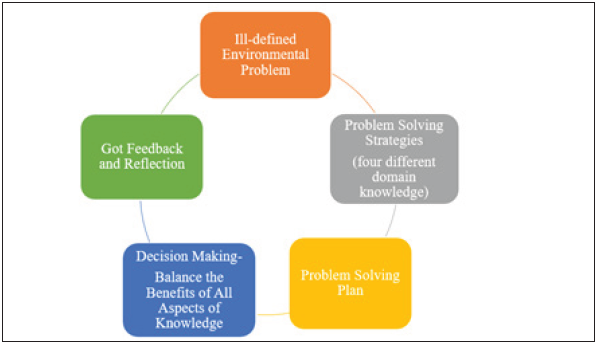Educational Revolution- Learning by Environmental Problem Solving (EPBL) by Kao YL in COJ Reviews & Research_open access publishers in usa
Opinion
The main purpose of education is developing human’s knowledge, skills and affections to recognize this world, solve problems in daily life and help human alive in the future. Many researchers in the world mentioned that students paid a lot of time in memorizing mathematics formula, science theory and language grammar, but cannot apply their knowledge to solve problem in their real life [1-3]. If people cannot solve problems, they cannot adapt themselves to live in the big environmental changes in the future. To sum up, to improve human’s problem-solving abilities by integrating his/her knowledge, skills and affections is the nature of education. But, do you ever think, what is the definition of “problems” and “environmental problems”?
Schraw et al. [4] indicated that problems could be defined as well-defined problems and ill-defined problems. The well-defined problems mean that this kind of problems are structural and could be solved in some specific domain knowledge, while the ill-defined problems did not be structural and could be solve in a lot of different ways. It seems that well-defined problems could be solved simply. Unfortunately, the problems in our real life are always be ill-defined problems [5]. On the other hand, what is “environmental problems”? The environmental problems might can be defined as “the problems which cannot be solved in this modern age”. It’s to say, if the environmental issues or pollutions could be solved right now, they would not stay here and to be disturbing problems.
In this decade, the environmental problems involved in the climate change issues, energy emergency, ocean crisis, micro plastic, etc. Each environmental problem could not be solved in just one or two domain knowledge. If human wants to make a better decision to solve the environmental problems, they should be considered in science, society, economy, etc. aspects of domain knowledge [6]. In other words, one must be integrated multiple domain knowledge and skills to think about an environmental problem solving. Thus, in this mini review article, this study provides a whole new concept which is “learning by Environmental Problem Solving (EPBL)” to drive an educational revolution.
There are five main steps to operate EPBL course (Figure 1). First, the idea we mentioned about EPBL should be started in an ill-defined environmental problem. Second, the learners should provide their problem-solving strategies in four different domain knowledge at least, such as Science, Technology, Engineering, Mathematics (STEM), society, economy, politics etc. Third, the learners should collect information, data and news to draw up a problemsolving plan. Fourth, the learners need to balance the benefits of all aspects of knowledge they chose and make a problem-solving decision. At last, the learners need to share their problem-solving strategies to others and collect the other’s feedbacks. This step could help the learners integrate their background knowledge, skills and affections by reflection, and improve them to reorganize/modify their problem-solving strategies more perfection (Figure 1). This article aims to provide a new idea - learning by EPBL to drive educational revolution. We believe that human need to be trained by integrating multiple domain knowledge and skills and have flexible thoughts to solve problems in daily life. Thus, human could alive in the rapidly changing environments in the future.
Figure 1:

References
- Cracolice MS, Deming JC, Ehlert B (2008) Concept learning versus problem solving: A cognitive difference. Journal of Chemical Education 85(6): 873-878.
- Linnette RL, Werner MA, David HMA (2020) Supporting problem solving in the leadership classroom: Using the pVASE framework for bridging theory to practice. Journal of Leadership Education 19(1): 44-52.
- Nakhleh MB (1993) Are our students’ conceptual thinkers or algorithmic problem solvers? Identifying Conceptual Students in General Chemistry. Journal of Chemical Education 70(1): 52-55.
- Schraw, Dunkle and Bendixen (1995) Cognitive processes in well‐defined and ill‐defined problem solving. Applied Cognitive Psychology 34(1): 1-292.
- Yeh FY, Liu CJ, Huang CF (2016) Explore students’ scientific and environmental learning process by using EPBL strategy.
- Adair J (2019) Decision making and problem solving. Kogan Page Ltd, London, UK.
Publishers: https://crimsonpublishers.com/




No comments:
Post a Comment